Self-Powered Sensing and Wireless Communication Synergic Systems Enabled by Triboelectric Nanogenerators
Abstract
:1. Introduction
2. Principles of TENGs
2.1. Maxwell’s Displacement Current
2.2. Equivalent Circuit Model of Capacitor and First-Order Lumped Parameters
2.3. TENG-Based Energy Harvesting and Self-Powered Sensing
2.4. TENG-Triggered Self-Powered Communication Model
3. Optimization Strategy of TENG-Enabled Wireless Communication System
3.1. Electric Displacement Field with TENG Itself
3.2. Modulated Electromagnetic Waves by TENG with Breakdown Discharge
3.3. Modulating Electromagnetic Waves by TENG Coupling Inductor
4. Applications of the Self-Powered Sensing and Wireless Communication Synergic Systems Enabled by TENGs
4.1. Underwater Systems
4.2. Smart Transportation
4.3. Other Applications in Security Systems, Human–Machine Interaction, and Healthcare
5. Summary and Outlook
Author Contributions
Funding
Data Availability Statement
Conflicts of Interest
References
- Shi, Q.; Zhang, Z.; He, T.; Sun, Z.; Wang, B.; Feng, Y.; Shan, X.; Salam, B.; Lee, C. Deep Learning Enabled Smart Mats as a Scalable Floor Monitoring System. Nat. Commun. 2020, 11, 4609. [Google Scholar] [PubMed]
- Jiang, L.; Tian, H.; Xing, Z.; Wang, K.; Zhang, K.; Maharjan, S.; Gjessing, S.; Zhang, Y. Social-Aware Energy Harvesting Device-to-Device Communications in 5G Networks. IEEE Wirel. Commun. 2016, 23, 20–27. [Google Scholar] [CrossRef]
- Zhao, X.; Askari, H.; Chen, J. Nanogenerators for Smart Cities in the Era of 5G and Internet of Things. Joule 2021, 5, 1391–1431. [Google Scholar] [CrossRef]
- Yang, X.; Liu, G.; Guo, Q.; Wen, H.; Huang, R.; Meng, X.; Duan, J.; Tang, Q. Triboelectric Sensor Array for Internet of Things Based Smart Traffic Monitoring and Management System. Nano Energy 2022, 92, 106757. [Google Scholar] [CrossRef]
- Yang, Y.; Guo, X.; Zhu, M.; Sun, Z.; Zhang, Z.; He, T.; Lee, C. Triboelectric Nanogenerator Enabled Wearable Sensors and Electronics for Sustainable Internet of Things Integrated Green Earth. Adv. Energy Mater. 2023, 13, 2203040. [Google Scholar]
- Shit, R.C.; Sharma, S.; Puthal, D.; Zomaya, A.Y. Location of Things (LoT): A Review and Taxonomy of Sensors Localization in IoT Infrastructure. IEEE Commun. Surv. Tutor. 2018, 20, 2028–2061. [Google Scholar]
- Liu, L.; Guo, X.; Lee, C. Promoting Smart Cities into the 5G Era with Multi-Field Internet of Things (IoT) Applications Powered with Advanced Mechanical Energy Harvesters. Nano Energy 2021, 88, 106304. [Google Scholar]
- Steeneken, P.G.; Kaiser, E.; Verbiest, G.J.; ten Veldhuis, M.-C. Sensors in Agriculture: Towards an Internet of Plants. Nat. Rev. Methods Primers 2023, 3, 1–2. [Google Scholar] [CrossRef]
- Potyrailo, R.A. Correction to Multivariable Sensors for Ubiquitous Monitoring of Gases in the Era of Internet of Things and Industrial Internet. Chem. Rev. 2016, 116, 11877–11923. [Google Scholar] [CrossRef]
- Yang, D.; Xing, Y.; Wang, J.; Hu, K.; Xiao, Y.; Tang, K.; Lyu, J.; Li, J.; Liu, Y.; Zhou, P.; et al. Multifactor Roadmap for Designing Low-Power-Consumed Micro Thermoelectric Thermostats in a Closed-Loop Integrated 5G Optical Module. Interdiscip. Mater. 2024, 3, 326–337. [Google Scholar]
- Wijethilaka, S.; Liyanage, M. Survey on Network Slicing for Internet of Things Realization in 5G Networks. IEEE Commun. Surv. Tutor. 2021, 23, 957–994. [Google Scholar] [CrossRef]
- Luo, Y.; Abidian, M.R.; Ahn, J.-H.; Akinwande, D.; Andrews, A.M.; Antonietti, M.; Bao, Z.; Berggren, M.; Berkey, C.A.; Bettinger, C.J.; et al. Technology Roadmap for Flexible Sensors. ACS Nano 2023, 17, 5211–5295. [Google Scholar] [PubMed]
- Shi, Q.; Dong, B.; He, T.; Sun, Z.; Zhu, J.; Zhang, Z.; Lee, C. Progress in Wearable Electronics/Photonics—Moving toward the Era of Artificial Intelligence and Internet of Things. InfoMat 2020, 2, 1131–1162. [Google Scholar] [CrossRef]
- Li, G.; Hu, Y.; Chen, J.; Liang, L.; Liu, Z.; Fu, J.; Du, C.; Chen, G. Thermoelectric and Photoelectric Dual Modulated Sensors for Human Internet of Things Application in Accurate Fire Recognition and Warning. Adv. Funct. Mater. 2023, 33, 2303861. [Google Scholar] [CrossRef]
- Cao, J.; Dong, Z.; Zhang, Z.; Gong, L.; Gao, Y.; Dai, Y.; Liu, G.; Feng, Y.; Jin, Z.; Luan, R.; et al. A Power-Managed Tribovoltaic Nanogenerator and Self-Powered Wireless Temperature Monitoring System. Adv. Energy Mater. 2024, 14, 2400659. [Google Scholar]
- Lu, Y.; Zhang, H.; Zhao, Y.; Liu, H.; Nie, Z.; Xu, F.; Zhu, J.; Huang, W. Robust Fiber-Shaped Flexible Temperature Sensors for Safety Monitoring with Ultrahigh Sensitivity. Adv. Mater. 2024, 36, 2310613. [Google Scholar] [CrossRef]
- Zou, J.; Ma, Y.; Liu, C.; Xie, Y.; Dai, X.; Li, X.; Li, S.; Peng, S.; Yue, Y.; Wang, S.; et al. Self-Powered Sensor Based on Compressible Ionic Gel Electrolyte for Simultaneous Determination of Temperature and Pressure. InfoMat 2024, 6, e12545. [Google Scholar] [CrossRef]
- Lei, D.; Zhang, Q.; Liu, N.; Su, T.; Wang, L.; Ren, Z.; Zhang, Z.; Su, J.; Gao, Y. Self-Powered Graphene Oxide Humidity Sensor Based on Potentiometric Humidity Transduction Mechanism. Adv. Funct. Mater. 2022, 32, 2107330. [Google Scholar] [CrossRef]
- Guo, P.; Tian, B.; Liang, J.; Yang, X.; Tang, G.; Li, Q.; Liu, Q.; Zheng, K.; Chen, X.; Wu, W. An All-Printed, Fast-Response Flexible Humidity Sensor Based on Hexagonal-WO3 Nanowires for Multifunctional Applications. Adv. Mater. 2023, 35, 2304420. [Google Scholar] [CrossRef]
- Xu, Q.; Tao, Y.; Wang, Z.; Zeng, H.; Yang, J.; Li, Y.; Zhao, S.; Tang, P.; Zhang, J.; Yan, M.; et al. Highly Flexible, High-Performance, and Stretchable Piezoelectric Sensor Based on a Hierarchical Droplet-Shaped Ceramics with Enhanced Damage Tolerance. Adv. Mater. 2024, 36, 2311624. [Google Scholar]
- Fu, Y.; Kang, S.; Xiang, G.; Su, C.; Gao, C.; Tan, L.; Gu, H.; Wang, S.; Zheng, Z.; Dai, S.; et al. Ultraflexible Temperature-Strain Dual-Sensor Based on Chalcogenide Glass-Polymer Film for Human-Machine Interaction. Adv. Mater. 2024, 36, 2313101. [Google Scholar] [CrossRef] [PubMed]
- Roy, A.; Zenker, S.; Jain, S.; Afshari, R.; Oz, Y.; Zheng, Y.; Annabi, N. A Highly Stretchable, Conductive, and Transparent Bioadhesive Hydrogel as a Flexible Sensor for Enhanced Real-Time Human Health Monitoring. Adv. Mater. 2024, 36, 2404225. [Google Scholar] [CrossRef] [PubMed]
- Zhang, X.; Chen, J.; Zheng, Z.; Tang, S.; Cheng, B.; Zhang, Z.; Ma, R.; Chen, Z.; Zhuo, J.; Cao, L.; et al. Flexible Temperature Sensor with High Reproducibility and Wireless Closed-Loop System for Decoupled Multimodal Health Monitoring and Personalized Thermoregulation. Adv. Mater. 2024, 36, 2407859. [Google Scholar] [CrossRef] [PubMed]
- He, H.; Yang, T.; Liu, T.; Gao, Y.; Zhang, Z.; Yang, Z.; Liang, F. Soft-Hard Janus Nanoparticles Triggered Hierarchical Conductors with Large Stretchability, High Sensitivity, and Superior Mechanical Properties. Adv. Mater. 2024, 36, 2312278. [Google Scholar] [CrossRef]
- Hong, J.; Wei, X.; Zhang, H.; Xiao, Y.; Meng, C.; Chen, Y.; Li, J.; Li, L.; Lee, S.; Shi, Q.; et al. Advances of Triboelectric and Piezoelectric Nanogenerators toward Continuous Monitoring and Multimodal Applications in the New Era. Int. J. Extrem. Manuf. 2024, 7, 012007. [Google Scholar] [CrossRef]
- Xiang, S.; Liu, D.; Jiang, C.; Zhou, W.; Ling, D.; Zheng, W.; Sun, X.; Li, X.; Mao, Y.; Shan, C. Liquid-Metal-Based Dynamic Thermoregulating and Self-Powered Electronic Skin. Adv. Funct. Mater. 2021, 31, 2100940. [Google Scholar] [CrossRef]
- Zou, Y.; Sun, M.; Li, S.; Zhang, X.; Feng, L.; Wang, Y.; Du, T.; Ji, Y.; Sun, P.; Xu, M. Advances in Self-Powered Triboelectric Sensor toward Marine IoT. Nano Energy 2024, 122, 109316. [Google Scholar] [CrossRef]
- Chaudhary, V.; Gautam, A.; Silotia, P.; Malik, S.; de Oliveira Hansen, R.; Khalid, M.; Khosla, A.; Kaushik, A.; Mishra, Y.K. Internet-of-Nano-Things (IoNT) Driven Intelligent Face Masks to Combat Airborne Health Hazard. Mater. Today 2022, 60, 201–226. [Google Scholar] [CrossRef]
- Wei, X.; Li, H.; Yue, W.; Gao, S.; Chen, Z.; Li, Y.; Shen, G. A High-Accuracy, Real-Time, Intelligent Material Perception System with a Machine-Learning-Motivated Pressure-Sensitive Electronic Skin. Matter 2022, 5, 1481–1501. [Google Scholar] [CrossRef]
- Kong, L.; Li, W.; Zhang, T.; Ma, H.; Cao, Y.; Wang, K.; Zhou, Y.; Shamim, A.; Zheng, L.; Wang, X.; et al. Wireless Technologies in Flexible and Wearable Sensing: From Materials Design, System Integration to Applications. Adv. Mater. 2024, 36, 2400333. [Google Scholar] [CrossRef]
- Andre, R.S.; Schneider, R.; DeLima, G.R.; Fugikawa-Santos, L.; Correa, D.S. Wireless Sensor for Meat Freshness Assessment Based on Radio Frequency Communication. ACS Sens. 2024, 9, 631–637. [Google Scholar] [CrossRef] [PubMed]
- Abu Ali, N.A.; Rehman, M.; Mumtaz, S.; Khan, M.B.; Hayajneh, M.; Ullah, F.; Shah, R.A. Contactless Diseases Diagnoses Using Wireless Communication Sensing: Methods and Challenges Survey. ACM Comput. Surv. 2024, 56, 226:1–226:29. [Google Scholar] [CrossRef]
- Lee, J.; Lee, A.-H.; Leung, V.; Laiwalla, F.; Lopez-Gordo, M.A.; Larson, L.; Nurmikko, A. An Asynchronous Wireless Network for Capturing Event-Driven Data from Large Populations of Autonomous Sensors. Nat. Electron. 2024, 7, 313–324. [Google Scholar] [CrossRef] [PubMed]
- Yu, H.; Xi, Z.; Du, H.; Yang, H.; Qian, Z.; Guo, X.; Guo, Y.; Huang, Y.; Du, T.; Xu, M. High Performance and Stackable Trampoline Like-Triboelectric Vibration Energy Harvester for In-Situ Powering Sensor Node with Data Wirelessly Transmitted Over 1000-m. Adv. Energy Mater. 2024, 14, 2400585. [Google Scholar] [CrossRef]
- Tang, H.; Yang, Y.; Liu, Z.; Li, W.; Zhang, Y.; Huang, Y.; Kang, T.; Yu, Y.; Li, N.; Tian, Y.; et al. Injectable Ultrasonic Sensor for Wireless Monitoring of Intracranial Signals. Nature 2024, 630, 84–90. [Google Scholar] [CrossRef]
- Zheng, Q.; Hou, Y.; Yang, H.; Tan, P.; Shi, H.; Xu, Z.; Ye, Z.; Chen, N.; Qu, X.; Han, X.; et al. Towards a Sustainable Monitoring: A Self-Powered Smart Transportation Infrastructure Skin. Nano Energy 2022, 98, 107245. [Google Scholar] [CrossRef]
- Zhao, Y.; Jin, K.-Q.; Li, J.-D.; Sheng, K.-K.; Huang, W.-H.; Liu, Y.-L. Flexible and Stretchable Electrochemical Sensors for Biological Monitoring. Adv. Mater. 2023, 2305917. [Google Scholar] [CrossRef]
- Yao, P.; Bao, Q.; Yao, Y.; Xiao, M.; Xu, Z.; Yang, J.; Liu, W. Environmentally Stable, Robust, Adhesive, and Conductive Supramolecular Deep Eutectic Gels as Ultrasensitive Flexible Temperature Sensor. Adv. Mater. 2023, 35, 2300114. [Google Scholar] [CrossRef]
- Kaidarova, A.; Geraldi, N.R.; Wilson, R.P.; Kosel, J.; Meekan, M.G.; Eguíluz, V.M.; Hussain, M.M.; Shamim, A.; Liao, H.; Srivastava, M.; et al. Wearable Sensors for Monitoring Marine Environments and Their Inhabitants. Nat. Biotechnol. 2023, 41, 1208–1220. [Google Scholar] [CrossRef]
- Kong, D.S.; Kim, K.H.; Hu, Y.C.; Kim, J.H.; Kim, I.; Lee, J.; Lee, J.; Shon, W.H.; Yoo, H.; Ro, C.-U.; et al. Flexoelectrically Augmented Triboelectrification Enabled Self-Power Wireless Smart Home Control System. Nano Energy 2024, 119, 109069. [Google Scholar] [CrossRef]
- Zhang, H.; Yin, F.; Shang, S.; Li, Y.; Qiu, Z.; Lin, Q.; Wei, X.; Li, S.; Kim, N.Y.; Shen, G. A High-Performance, Biocompatible, and Degradable Piezoresistive-Triboelectric Hybrid Device for Cross-Scale Human Activities Monitoring and Self-Powered Smart Home System. Nano Energy 2022, 102, 107687. [Google Scholar]
- Duan, S.; Shi, Q.; Hong, J.; Zhu, D.; Lin, Y.; Li, Y.; Lei, W.; Lee, C.; Wu, J. Water-Modulated Biomimetic Hyper-Attribute-Gel Electronic Skin for Robotics and Skin-Attachable Wearables. ACS Nano 2023, 17, 1355–1371. [Google Scholar]
- Chen, Y.; Hong, J.; Xiao, Y.; Zhang, H.; Wu, J.; Shi, Q. Multimodal Intelligent Flooring System for Advanced Smart-Building Monitoring and Interactions. Adv. Sci. 2024, 11, 2406190. [Google Scholar] [CrossRef] [PubMed]
- Hong, J.; Rao, Z.; Duan, S.; Xiang, S.; Wei, X.; Xiao, Y.; Chen, Y.; Sheng, H.; Xia, J.; Lei, W.; et al. A Paradigm Shift toward Active Resistive Sensing Driven by Triboelectric Nanogenerator. Nano Energy 2024, 131, 110327. [Google Scholar]
- Shi, Q.; Yang, Y.; Sun, Z.; Lee, C. Progress of Advanced Devices and Internet of Things Systems as Enabling Technologies for Smart Homes and Health Care. ACS Mater. Au 2022, 2, 394–435. [Google Scholar]
- Zhou, W.; Tuo, L.; Tang, W.; Wen, H.; Chen, C.; Ning, H.; Long, S.; Wan, L.; Liu, G.; Wang, Z.L. Four-Helix Triboelectric Nanogenerator Based on Wave Amplitude Amplifier. Adv. Energy Mater. 2024, 2402781. [Google Scholar] [CrossRef]
- Xia, Y.; Zhi, J.; Zhang, R.; Zhou, F.; Liu, S.; Xu, Q.; Qin, Y. Synchronous Switching Strategy to Enhance the Real-Time Powering and Charging Performance of Triboelectric Nanogenerator. Adv. Mater. 2024, 36, 2403361. [Google Scholar]
- Shao, B.; Lu, T.-C.; Lu, M.-H.; Chen, Y.-T.; Wu, T.-C.; Peng, W.-C.; Ko, T.-Y.; Chen, J.-Y.; Sun, B.; Chen, C.-Y.; et al. Efficient Permeable Monolithic Hybrid Tribo-Piezo-Electromagnetic Nanogenerator Based on Topological-Insulator-Composite. Adv. Mater. 2024, 36, 2408936. [Google Scholar] [CrossRef]
- Liu, K.; Ding, T.; Li, J.; Chen, Q.; Xue, G.; Yang, P.; Xu, M.; Wang, Z.L.; Zhou, J. Thermal–Electric Nanogenerator Based on the Electrokinetic Effect in Porous Carbon Film. Adv. Energy Mater. 2018, 8, 1702481. [Google Scholar]
- Liu, L.; Zhang, D.; Bai, P.; Mao, Y.; Li, Q.; Guo, J.; Fang, Y.; Ma, R. Strong Tough Thermogalvanic Hydrogel Thermocell With Extraordinarily High Thermoelectric Performance. Adv. Mater. 2023, 35, 2300696. [Google Scholar]
- Zhi, C.; Shi, S.; Wu, H.; Si, Y.; Zhang, S.; Lei, L.; Hu, J. Emerging Trends of Nanofibrous Piezoelectric and Triboelectric Applications: Mechanisms, Electroactive Materials, and Designed Architectures. Adv. Mater. 2024, 36, 2401264. [Google Scholar] [CrossRef] [PubMed]
- Gong, S.; Wang, X.; Tang, B.; Xiong, Z.; Qi, S.; Chen, J.; Yu, P.; Guo, H. Achieving Self-Reinforcing Triboelectric-Electromagnetic Hybrid Nanogenerator by Magnetocaloric and Magnetization Effects of Gadolinium. Adv. Mater. 2024, 36, 2402824. [Google Scholar]
- Zhang, C.; Yang, S.; Dai, X.; Tu, Y.; Du, Z.; Wu, X.; Huang, Y.; Fan, J.; Hong, Z.; Jiang, T.; et al. Hybridized Triboelectric-Electromagnetic Nanogenerators for Efficient Harvesting of Wave Energy for Self-Powered Ocean Buoy. Nano Energy 2024, 128, 109929. [Google Scholar]
- Duan, J.; Liu, Z.; Wang, X.; Li, T.J.; Wang, Y. Recent Advances in Skin Waste Heat Energy Harvesting Wearable Flexible Thermo-Electric and Moist-Electric Devices. Renew. Sustain. Energy Rev. 2024, 202, 114719. [Google Scholar]
- Tang, J.; Xue, J.; Xu, H.; Li, Y.; Lin, S.; Li, B.; Zhong, D.; Li, G.; Jiang, Y.; Chen, Q. Power Generation Density Boost of Bifacial Tandem Solar Cells Revealed by High Throughput Optoelectrical Modelling. Energy Environ. Sci. 2024, 17, 6068–6078. [Google Scholar]
- Fan, F.-R.; Tian, Z.-Q.; Lin Wang, Z. Flexible Triboelectric Generator. Nano Energy 2012, 1, 328–334. [Google Scholar]
- Chen, B.; Yang, Y.; Wang, Z.L. Scavenging Wind Energy by Triboelectric Nanogenerators. Adv. Energy Mater. 2018, 8, 1702649. [Google Scholar]
- Wu, C.; Wang, A.C.; Ding, W.; Guo, H.; Wang, Z.L. Triboelectric Nanogenerator: A Foundation of the Energy for the New Era. Adv. Energy Mater. 2019, 9, 1802906. [Google Scholar]
- Wang, Z.L. Triboelectric Nanogenerator (TENG)—Sparking an Energy and Sensor Revolution. Adv. Energy Mater. 2020, 10, 2000137. [Google Scholar]
- Jiang, T.; Pang, H.; An, J.; Lu, P.; Feng, Y.; Liang, X.; Zhong, W.; Wang, Z.L. Robust Swing-Structured Triboelectric Nanogenerator for Efficient Blue Energy Harvesting. Adv. Energy Mater. 2020, 10, 2000064. [Google Scholar]
- Wei, Z.; Wang, J.; Liu, Y.; Yuan, J.; Liu, T.; Du, G.; Zhu, S.; Nie, S. Sustainable Triboelectric Materials for Smart Active Sensing Systems. Adv. Funct. Mater. 2022, 32, 2208277. [Google Scholar] [CrossRef]
- Wang, X.; Zhang, Y.; Zhang, X.; Huo, Z.; Li, X.; Que, M.; Peng, Z.; Wang, H.; Pan, C. A Highly Stretchable Transparent Self-Powered Triboelectric Tactile Sensor with Metallized Nanofibers for Wearable Electronics. Adv. Mater. 2018, 30, 1706738. [Google Scholar]
- Hui, X.; Tang, L.; Zhang, D.; Yan, S.; Li, D.; Chen, J.; Wu, F.; Wang, Z.L.; Guo, H. Acoustically Enhanced Triboelectric Stethoscope for Ultrasensitive Cardiac Sounds Sensing and Disease Diagnosis. Adv. Mater. 2024, 36, 2401508. [Google Scholar]
- Peng, W.; Zhu, R.; Ni, Q.; Zhao, J.; Zhu, X.; Mei, Q.; Zhang, C.; Liao, L. Functional Tactile Sensor Based on Arrayed Triboelectric Nanogenerators. Adv. Energy Mater. 2024, 14, 2403289. [Google Scholar]
- Huang, M.-Z.; Parashar, P.; Chen, A.-R.; Shi, S.-C.; Tseng, Y.-H.; Lim, K.C.; Yeh, H.-Y.; Pal, A.; Kang, D.-Y.; Lin, Z.-H. Snake-Scale Stimulated Robust Biomimetic Composite Triboelectric Layer for Energy Harvesting and Smart Health Monitoring. Nano Energy 2024, 122, 109266. [Google Scholar]
- Zhao, Y.; Gao, W.; Dai, K.; Wang, S.; Yuan, Z.; Li, J.; Zhai, W.; Zheng, G.; Pan, C.; Liu, C.; et al. Bioinspired Multifunctional Photonic-Electronic Smart Skin for Ultrasensitive Health Monitoring, for Visual and Self-Powered Sensing. Adv. Mater. 2021, 33, 2102332. [Google Scholar]
- Kim, Y.-J.; Lee, J.; Hwang, J.-H.; Chung, Y.; Park, B.-J.; Kim, J.; Kim, S.-H.; Mun, J.; Yoon, H.-J.; Park, S.-M.; et al. High-Performing and Capacitive-Matched Triboelectric Implants Driven by Ultrasound. Adv. Mater. 2024, 36, 2307194. [Google Scholar] [CrossRef]
- Yuan, Y.; Li, H.; Song, Y.; Zhang, D.; Wang, Z.; Yi, X.; Qi, B.; Zhang, X.; Jiang, P.; Yu, A. Drug-Free “Triboelectric Immunotherapy” Activating Immunity for Osteomyelitis Treatment and Recurrence Prevention. Adv. Mater. 2024, 36, 2408473. [Google Scholar]
- Duan, S.; Zhang, H.; Liu, L.; Lin, Y.; Zhao, F.; Chen, P.; Cao, S.; Zhou, K.; Gao, C.; Liu, Z.; et al. A Comprehensive Review on Triboelectric Sensors and AI-Integrated Systems. Mater. Today 2024, 80, 450–480. [Google Scholar] [CrossRef]
- Xu, Y.; Bai, Z.; Xu, G. Constructing High-Efficiency Stretchable-Breathable Triboelectric Fabric for Biomechanical Energy Harvesting and Intelligent Sensing. Nano Energy 2023, 108, 108224. [Google Scholar]
- Khan, A.A.; Mahmud, A.; Zhang, S.; Islam, S.; Voss, P.; Ban, D. A Self-Powered Multi-Broadcasting Wireless Sensing System Realized with an All-in-One Triboelectric Nanogenerator. Nano Energy 2019, 62, 691–699. [Google Scholar]
- Lu, S.; Gao, L.; Chen, X.; Tong, D.; Lei, W.; Yuan, P.; Mu, X.; Yu, H. Simultaneous Energy Harvesting and Signal Sensing from a Single Triboelectric Nanogenerator for Intelligent Self-Powered Wireless Sensing Systems. Nano Energy 2020, 75, 104813. [Google Scholar]
- Sou, K.W.; Lin, Z.; Jin, Y.; Ping, S.; Ding, W.; Wang, J. A Hybrid Wind and Raindrop Energy Harvesting Operating on Savonius Turbine. Nano Energy 2024, 127, 109746. [Google Scholar]
- Kim, D.-H.; Kim, J.-K.; Choi, S.Y.; Yang, Y.; Song, H.-C.; Park, H.S.; Shim, M.; Baik, J.M. Addressing Triboelectric Nanogenerator Impedance for Efficient CO2 Utilization. Adv. Energy Mater. 2024, 14, 2304012. [Google Scholar] [CrossRef]
- Hwang, H.J.; Kwon, D.; Kwon, H.-Y.; Shim, M.; Baik, J.M.; Choi, D. Integrated System of Mechanical Regulator and Electrical Circuitry on Triboelectric Energy Harvesting with Near-Field Communication for Low Power Consumption. Adv. Energy Mater. 2024, 2400481. [Google Scholar] [CrossRef]
- Mallineni, S.S.K.; Dong, Y.; Behlow, H.; Rao, A.M.; Podila, R. A Wireless Triboelectric Nanogenerator. Adv. Energy Mater. 2018, 8, 1702736. [Google Scholar]
- Jie, Y.; Ma, J.; Chen, Y.; Cao, X.; Wang, N.; Wang, Z.L. Efficient Delivery of Power Generated by a Rotating Triboelectric Nanogenerator by Conjunction of Wired and Wireless Transmissions Using Maxwell’s Displacement Currents. Adv. Energy Mater. 2018, 8, 1802084. [Google Scholar] [CrossRef]
- Wang, H.; Fu, J.; Wang, J.; Su, L.; Zi, Y. Tribophotonics: An Emerging Self-Powered Wireless Solution toward Smart City. Nano Energy 2022, 97, 107196. [Google Scholar]
- Zeng, Y.; Cheng, Y.; Zhu, J.; Jie, Y.; Ma, P.; Lu, H.; Cao, X.; Wang, Z.L. Self-Powered Sensors Driven by Maxwell’s Displacement Current Wirelessly Provided by TENG. Appl. Mater. Today 2022, 27, 101375. [Google Scholar]
- Yin, W.; Xie, Y.; Long, J.; Zhao, P.; Chen, J.; Luo, J.; Wang, X.; Dong, S. A Self-Power-Transmission and Non-Contact-Reception Keyboard Based on a Novel Resonant Triboelectric Nanogenerator (R-TENG). Nano Energy 2018, 50, 16–24. [Google Scholar]
- Das, N.K.; Ravipati, M.; Badhulika, S. Nickel Metal-Organic Framework/PVDF Composite Nanofibers-Based Self-Powered Wireless Sensor for Pulse Monitoring of Underwater Divers via Triboelectrically Generated Maxwell’s Displacement Current. Adv. Funct. Mater. 2023, 33, 2303288. [Google Scholar]
- Gu, H.; Lu, B.; Gao, Z.; Wu, S.; Zhang, L.; Xie, L.; Yi, J.; Liu, Y.; Nie, B.; Wen, Z.; et al. A Battery-Free Wireless Tactile Sensor for Multimodal Force Perception. Adv. Funct. Mater. 2024, 2410661. [Google Scholar] [CrossRef]
- Wang, Z.L. On Maxwell’s Displacement Current for Energy and Sensors: The Origin of Nanogenerators. Mater. Today 2017, 20, 74–82. [Google Scholar] [CrossRef]
- Niu, S.; Wang, Z.L. Theoretical Systems of Triboelectric Nanogenerators. Nano Energy 2015, 14, 161–192. [Google Scholar] [CrossRef]
- Li, H.; Zhang, Z.; Xu, P.; Jiang, C.; Yu, L. A Vortex-Induced Vibration Device Based on MG-TENG and Research of Its Application in Ocean Current Energy Harvesting. Nano Energy 2024, 124, 109457. [Google Scholar]
- Kou, Z.; Zhang, C.; Yu, B.; Chen, H.; Liu, Z.; Lu, W. Wearable All-Fabric Hybrid Energy Harvester to Simultaneously Harvest Radiofrequency and Triboelectric Energy. Adv. Sci. 2024, 11, 2309050. [Google Scholar]
- Liang, X.; Liu, Z.; Han, K.; Liu, S.; Xie, Y.; Jiang, T.; Wang, Z.L. Triboelectric Nanogenerators Using Recycled Disposable Medical Masks for Water Wave Energy Harvesting. Adv. Funct. Mater. 2024, 34, 2409422. [Google Scholar]
- He, T.; Wang, H.; Wang, J.; Tian, X.; Wen, F.; Shi, Q.; Ho, J.S.; Lee, C. Self-Sustainable Wearable Textile Nano-Energy Nano-System (NENS) for Next-Generation Healthcare Applications. Adv. Sci. 2019, 6, 1901437. [Google Scholar]
- Liu, J.; Liu, M.; Sun, C.; Lin, Z.; Feng, Z.; Si, S.; Yang, J. Triboelectric Hydrophone for Underwater Detection of Low-Frequency Sounds. Nano Energy 2022, 99, 107428. [Google Scholar]
- Tang, Q.; Wang, Z.; Chang, W.; Sun, J.; He, W.; Zeng, Q.; Guo, H.; Hu, C. Interface Static Friction Enabled Ultra-Durable and High Output Sliding Mode Triboelectric Nanogenerator. Adv. Funct. Mater. 2022, 32, 2202055. [Google Scholar] [CrossRef]
- Zhu, M.; Sun, Z.; Chen, T.; Lee, C. Low Cost Exoskeleton Manipulator Using Bidirectional Triboelectric Sensors Enhanced Multiple Degree of Freedom Sensory System. Nat. Commun. 2021, 12, 2692. [Google Scholar] [PubMed]
- Akram, W.; Chen, Q.; Xia, G.; Fang, J. A Review of Single Electrode Triboelectric Nanogenerators. Nano Energy 2023, 106, 108043. [Google Scholar]
- Zhang, H.; Li, H.; Li, Y. Biomimetic Electronic Skin for Robots Aiming at Superior Dynamic-Static Perception and Material Cognition Based on Triboelectric-Piezoresistive Effects. Nano Lett. 2024, 24, 4002–4011. [Google Scholar] [CrossRef]
- Dharmasena, R.D.I.G.; Silva, S.R.P. Towards Optimized Triboelectric Nanogenerators. Nano Energy 2019, 62, 530–549. [Google Scholar]
- Wang, J.; Ding, W.; Pan, L.; Wu, C.; Yu, H.; Yang, L.; Liao, R.; Wang, Z.L. Self-Powered Wind Sensor System for Detecting Wind Speed and Direction Based on a Triboelectric Nanogenerator. ACS Nano 2018, 12, 3954–3963. [Google Scholar] [PubMed]
- Zhao, H.; Xu, M.; Shu, M.; An, J.; Ding, W.; Liu, X.; Wang, S.; Zhao, C.; Yu, H.; Wang, H.; et al. Underwater Wireless Communication via TENG-Generated Maxwell’s Displacement Current. Nat. Commun. 2022, 13, 3325. [Google Scholar] [PubMed]
- Ma, W.; Wang, P.; Zhang, B.; Li, X.; Gao, Y.; Zhao, Z.; Liu, D.; Li, C.; Wang, J. A Self-Powered Multiphase Flow Detection Through Triboelectric Nanogenerator-Based Displacement Current. Adv. Energy Mater. 2024, 14, 2304331. [Google Scholar]
- Wang, H.; Wang, J.; Yao, K.; Fu, J.; Xia, X.; Zhang, R.; Li, J.; Xu, G.; Wang, L.; Yang, J.; et al. A Paradigm Shift Fully Self-Powered Long-Distance Wireless Sensing Solution Enabled by Discharge-Induced Displacement Current. Sci. Adv. 2021, 7, eabi6751. [Google Scholar]
- Kuang, H.; Huang, S.; Zhang, C.; Chen, J.; Shi, L.; Zeng, X.; Li, Y.; Yang, Z.; Wang, X.; Dong, S.; et al. Electric-Field-Resonance-Based Wireless Triboelectric Nanogenerators and Sensors. ACS Appl. Mater. Interfaces 2021, 14, 794–804. [Google Scholar] [CrossRef]
- Zhang, X.; Yang, Q.; Ren, D.; Yang, H.; Li, X.; Li, Q.; Liu, H.; Hu, C.; He, X.; Xi, Y. Omnidirectional Water Wave-Driven Triboelectric Net-Zero Power Smart Ocean Network: An Advanced Hardware Solution to Long-Distance Target Detection. Nano Energy 2023, 114, 108614. [Google Scholar] [CrossRef]
- Zhang, C.; Chen, J.; Xuan, W.; Huang, S.; You, B.; Li, W.; Sun, L.; Jin, H.; Wang, X.; Dong, S.; et al. Conjunction of Triboelectric Nanogenerator with Induction Coils as Wireless Power Sources and Self-Powered Wireless Sensors. Nat. Commun. 2020, 11, 58. [Google Scholar] [PubMed]
- Xu, L.; Xuan, W.; Chen, J.; Zhang, C.; Tang, Y.; Huang, X.; Li, W.; Jin, H.; Dong, S.; Yin, W.; et al. Fully Self-Powered Instantaneous Wireless Humidity Sensing System Based on Triboelectric Nanogenerator. Nano Energy 2021, 83, 105814. [Google Scholar]
- Tang, Y.; Xuan, W.; Zhang, C.; Xu, L.; Liu, F.; Chen, J.; Jin, H.; Ye, Z.; Cao, Z.; Li, Y.; et al. Fully Self-Powered Instantaneous Wireless Traffic Monitoring System Based on Triboelectric Nanogenerator and Magnetic Resonance Coupling. Nano Energy 2021, 89, 106429. [Google Scholar]
- Wang, T.; Wang, C.; Zeng, Q.; Gu, G.; Wang, X.; Cheng, G.; Du, Z. A Real-Time, Self-Powered Wireless Pressure Sensing System with Efficient Coupling Energy Harvester, Sensing, and Communication Modules. Nano Energy 2024, 125, 109533. [Google Scholar]
- Zhang, C.; Chen, J.; Xuan, W.; Huang, S.; Shi, L.; Cao, Z.; Ye, Z.; Li, Y.; Wang, X.; Dong, S.; et al. Triboelectric Nanogenerator-Enabled Fully Self-Powered Instantaneous Wireless Sensor Systems. Nano Energy 2022, 92, 106770. [Google Scholar]
- Wen, F.; Wang, H.; He, T.; Shi, Q.; Sun, Z.; Zhu, M.; Zhang, Z.; Cao, Z.; Dai, Y.; Zhang, T.; et al. Battery-Free Short-Range Self-Powered Wireless Sensor Network (SS-WSN) Using TENG Based Direct Sensory Transmission (TDST) Mechanism. Nano Energy 2020, 67, 104266. [Google Scholar]
- Cao, X.; Zhang, M.; Huang, J.; Jiang, T.; Zou, J.; Wang, N.; Wang, Z.L. Inductor-Free Wireless Energy Delivery via Maxwell’s Displacement Current from an Electrodeless Triboelectric Nanogenerator. Adv. Mater. 2018, 30, 1704077. [Google Scholar]
- Tang, L.; Hui, X.; Chen, J.; Guo, H.; Wu, F. Self-Powered, Anti-Detectable Wireless near-Field Communication Strategy Based on Mechano-Driven Maxwell’s Displacement Current. Nano Energy 2023, 118, 109001. [Google Scholar]
- Wang, Z.; Wan, D.; Fang, R.; Yuan, Z.; Zhuo, K.; Wang, T.; Zhang, H. Water-Based Triboelectric Nanogenerator for Wireless Energy Transmission and Self-Powered Communication via a Solid-Liquid-Solid Interaction. Appl. Surf. Sci. 2022, 605, 154765. [Google Scholar] [CrossRef]
- Cui, J.; Liu, T.; Zheng, Y.; Bai, S.; Li, X.; Xue, C. Optimization of Electromagnetic-Triboelectric Wind Energy Harvester Based on Coaxial Reversed Mechanism with Tip Discharge. Energy Convers. Manag. 2023, 293, 117456. [Google Scholar]
- Luo, J.; Xu, L.; Tang, W.; Jiang, T.; Fan, F.R.; Pang, Y.; Chen, L.; Zhang, Y.; Wang, Z.L. Direct-Current Triboelectric Nanogenerator Realized by Air Breakdown Induced Ionized Air Channel. Adv. Energy Mater. 2018, 8, 1800889. [Google Scholar] [CrossRef]
- Zhang, C.; Chen, J.; Zhou, Y.; Zhang, C.; Chang, S.; Xuan, W.; Jin, H.; Dong, S.; Luo, J. A Battery-Less Self-Powered Dual-Parameter Omnidirectional Wireless Sensing System Based on Symmetrical Resonant Circuit. Nano Energy 2024, 125, 109536. [Google Scholar]
- Wang, H.; Xia, X.; Fu, J.; Li, J.; Chen, C.; Dai, Y.; Fan, Z.; Hu, G.; Zi, Y. A General Self-Powered Wireless Sensing Solution Based on Triboelectric-Discharge Effect. Nano Energy 2023, 105, 107982. [Google Scholar]
- Shinohara, N. The Wireless Power Transmission: Inductive Coupling, Radio Wave, and Resonance Coupling. WIREs Energy Environ. 2012, 1, 337–346. [Google Scholar]
- Yun, J.; Kim, I.; Kim, D. Triboelectric Energy Harvesting Using Inductor towards Self-Powered Real-Time Wireless Communication System. Nano Energy 2023, 115, 108760. [Google Scholar] [CrossRef]
- Chen, J.; Liao, Z.; Wu, Y.; Zhou, H.; Xuan, W.; Dong, S.; Luo, J. Self-Powered Pumping Switched TENG Enabled Real-Time Wireless Metal Tin Height and Position Recognition and Counting for Production Line Management. Nano Energy 2021, 90, 106544. [Google Scholar]
- Zhang, W.; He, W.; Dai, S.; Ma, F.; Lin, P.; Sun, J.; Dong, L.; Hu, C. Wave Energy Harvesting Based on Multilayer Beads Integrated Spherical TENG with Switch Triggered Instant Discharging for Self-Powered Hydrogen Generation. Nano Energy 2023, 111, 108432. [Google Scholar]
- Chen, J.; Zhang, C.; Xuan, W.; Yu, L.; Dong, S.; Xie, Y.; Yin, W.; Luo, J. Triboelectric Nanogenerator-Based Self-Powered Resonant Sensor for Non-Destructive Defect Detection. Sensors 2019, 19, 3262. [Google Scholar] [CrossRef]
- Liufu, Y.H.; Dai, D.; Liu, Z. Triple-MOSFETs Switch for Adaptive Maximum Capacitance Point Tracking of Triboelectric Nanogenerators. Nano Energy 2023, 106, 108042. [Google Scholar] [CrossRef]
- Chen, J.; Xuan, W.; Zhao, P.; Farooq, U.; Ding, P.; Yin, W.; Jin, H.; Wang, X.; Fu, Y.; Dong, S.; et al. Triboelectric Effect Based Instantaneous Self-Powered Wireless Sensing with Self-Determined Identity. Nano Energy 2018, 51, 1–9. [Google Scholar]
- Sun, C.; Si, S.; Liu, J.; Xia, Y.; Lin, Z.; He, Q.; Wang, H.; Chen, L.; Wu, H.; Liu, J.; et al. Flexible, Ultra-Wideband Acoustic Device for Ultrasound Energy Harvesting and Passive Wireless Sensing. Nano Energy 2023, 112, 108430. [Google Scholar] [CrossRef]
- Su, Y.; Chen, S.; Liu, B.; Lu, H.; Luo, X.; Chen, C.; Li, W.; Long, Y.; Tai, H.; Xie, G.; et al. Maxwell Displacement Current Induced Wireless Self-Powered Gas Sensor Array. Mater. Today Phys. 2023, 30, 100951. [Google Scholar] [CrossRef]
- Yin, J.; Wang, Y.; Wang, L.; Hui, J. Multiuser Underwater Acoustic Communication Using Single-Element Virtual Time Reversal Mirror. Chin. Sci. Bull. 2009, 54, 1302–1310. [Google Scholar] [CrossRef]
- Wang, C.; Zhang, B.; Li, Y.; Zhao, X. Suspended Graphene Hydroacoustic Sensor for Broadband Underwater Wireless Communications. IEEE Wirel. Commun. 2020, 27, 44–52. [Google Scholar]
- Toky, A.; Singh, R.P.; Das, S. Localization Schemes for Underwater Acoustic Sensor Networks—A Review. Comput. Sci. Rev. 2020, 37, 100241. [Google Scholar] [CrossRef]
- Zhu, H.; Chen, H.; Fei, J.; Deng, Y.; Yang, T.; Chen, P.; Liang, Y.; Cai, Y.; Zhu, L.; Huang, Z. Solution-Processed CsPbBr3 Perovskite Films via CsBr Intercalated PbBr2 Intermediate for High-Performance Photodetectors towards Underwater Wireless Optical Communication. Nano Energy 2024, 125, 109513. [Google Scholar] [CrossRef]
- Zeng, Z.; Fu, S.; Zhang, H.; Dong, Y.; Cheng, J. A Survey of Underwater Optical Wireless Communications. IEEE Commun. Surv. Tutor. 2017, 19, 204–238. [Google Scholar]
- Cheng, Z.; Zhou, J.; Wang, B.; Wu, Q.; Ma, L.; Qin, Z.; Shen, J.; Chen, W.; Peng, W.; Chang, J.; et al. A Bionic Flapping Magnetic-Dipole Resonator for ELF Cross-Medium Communication. Adv. Sci. 2024, 11, 2403746. [Google Scholar] [CrossRef]
- Li, Y.; Wang, S.; Jin, C.; Zhang, Y.; Jiang, T. A Survey of Underwater Magnetic Induction Communications: Fundamental Issues, Recent Advances, and Challenges. IEEE Commun. Surv. Tutor. 2019, 21, 2466–2487. [Google Scholar] [CrossRef]
- Yang, D.; Zhang, L.; Wang, N.; Yu, T.; Sun, W.; Luo, N.; Feng, Y.; Liu, W.; Wang, D. Humidity-Resistant Triboelectric Nanogenerator Based on a Swelling-Resistant and Antiwear PAN/PVA-CaCl2 Composite Film for Seawater Desalination. Adv. Funct. Mater. 2024, 34, 2306702. [Google Scholar]
- Feng, L.; Natu, S.; Som de Cerff Edmonds, V.; Valenza, J.J. Multiphase Flow Detection with Photonic Crystals and Deep Learning. Nat. Commun. 2022, 13, 567. [Google Scholar] [CrossRef] [PubMed]
- Deng, F.; Xiong, C.; Chen, S.; Chen, G.; Wang, M.; Liu, H.; Zhang, J.; Lei, Q.; Cao, G.; Xu, D.; et al. A Method and Device for Online Magnetic Resonance Multiphase Flow Detection. Pet. Explor. Dev. 2020, 47, 855–866. [Google Scholar] [CrossRef]
- Paranjape, M.V.; Manchi, P.; Kurakula, A.; Kavarthapu, V.S.; Lee, J.K.; Graham, S.A.; Yu, J.S. Generalized Utilization of Energy Harvesting Ability of TENG for Concurrent Energy Storage and Motion Sensing Application with Effective External Circuitry. Nano Energy 2024, 129, 109983. [Google Scholar] [CrossRef]
- Pang, Y.; Zhu, X.; Yu, Y.; Liu, S.; Chen, Y.; Feng, Y. Waterbomb-Origami Inspired Triboelectric Nanogenerator for Smart Pavement-Integrated Traffic Monitoring. Nano Res. 2022, 15, 5450–5460. [Google Scholar]
- Zhang, X.; Yang, Z.; Yang, S.; Zhang, X.; Li, H.; Lu, X.; Zhang, B.; Wang, Z.L.; Cheng, T. Deep Learning Assisted Three Triboelectric Driving Operation Sensors for Driver Training and Behavior Monitoring. Mater. Today 2024, 72, 47–56. [Google Scholar]
- Askari, H.; Khajepour, A.; Khamesee, M.B.; Wang, Z.L. Embedded Self-Powered Sensing Systems for Smart Vehicles and Intelligent Transportation. Nano Energy 2019, 66, 104103. [Google Scholar]
- Pang, Y.; Zhu, X.; Lee, C.; Liu, S. Triboelectric Nanogenerator as Next-Generation Self-Powered Sensor for Cooperative Vehicle-Infrastructure System. Nano Energy 2022, 97, 107219. [Google Scholar]
- Xu, Y.; Yang, W.; Yu, X.; Li, H.; Cheng, T.; Lu, X.; Wang, Z.L. Real-Time Monitoring System of Automobile Driver Status and Intelligent Fatigue Warning Based on Triboelectric Nanogenerator. ACS Nano 2021, 15, 7271–7278. [Google Scholar]
- Kumar, A.; Kashiyama, T.; Maeda, H.; Omata, H.; Sekimoto, Y. Real-Time Citywide Reconstruction of Traffic Flow from Moving Cameras on Lightweight Edge Devices. ISPRS J. Photogramm. Remote Sens. 2022, 192, 115–129. [Google Scholar] [CrossRef]
- Hou, Y.; Li, Q.; Zhang, C.; Lu, G.; Ye, Z.; Chen, Y.; Wang, L.; Cao, D. The State-of-the-Art Review on Applications of Intrusive Sensing, Image Processing Techniques, and Machine Learning Methods in Pavement Monitoring and Analysis. Engineering 2021, 7, 845–856. [Google Scholar] [CrossRef]
- Pandey, P.; Thapa, K.; Ojha, G.P.; Seo, M.-K.; Shin, K.H.; Kim, S.-W.; Sohn, J.I. Metal-Organic Frameworks-Based Triboelectric Nanogenerator Powered Visible Light Communication System for Wireless Human-Machine Interactions. Chem. Eng. J. 2023, 452, 139209. [Google Scholar] [CrossRef]
- Niu, L.; Peng, X.; Chen, L.; Liu, Q.; Wang, T.; Dong, K.; Pan, H.; Cong, H.; Liu, G.; Jiang, G.; et al. Industrial Production of Bionic Scales Knitting Fabric-Based Triboelectric Nanogenerator for Outdoor Rescue and Human Protection. Nano Energy 2022, 97, 107168. [Google Scholar]
- Deng, J.; Wu, Z.; Huo, X.; Chen, Y.; Qian, H.; Tang, T.; Ge, X.; Wang, Y. Triboelectric Based Smart Ceramic Tiles. Nano Energy 2024, 128, 109928. [Google Scholar] [CrossRef]
- Sun, Z.; Zhu, M.; Zhang, Z.; Chen, Z.; Shi, Q.; Shan, X.; Yeow, R.C.H.; Lee, C. Artificial Intelligence of Things (AIoT) Enabled Virtual Shop Applications Using Self-Powered Sensor Enhanced Soft Robotic Manipulator. Adv. Sci. 2021, 8, 2100230. [Google Scholar] [CrossRef]
- Sun, Z.; Zhu, M.; Shan, X.; Lee, C. Augmented Tactile-Perception and Haptic-Feedback Rings as Human-Machine Interfaces Aiming for Immersive Interactions. Nat. Commun. 2022, 13, 5224. [Google Scholar]
- Chen, T.; Zhao, M.; Shi, Q.; Yang, Z.; Liu, H.; Sun, L.; Ouyang, J.; Lee, C. Novel Augmented Reality Interface Using a Self-Powered Triboelectric Based Virtual Reality 3D-Control Sensor. Nano Energy 2018, 51, 162–172. [Google Scholar]
- Hou, C.; Geng, J.; Yang, Z.; Tang, T.; Sun, Y.; Wang, F.; Liu, H.; Chen, T.; Sun, L. A Delta-Parallel-Inspired Human Machine Interface by Using Self-Powered Triboelectric Nanogenerator Toward 3D and VR/AR Manipulations. Adv. Mater. Technol. 2021, 6, 2000912. [Google Scholar]
- Fang, H.; Guo, J.; Wu, H. Wearable Triboelectric Devices for Haptic Perception and VR/AR Applications. Nano Energy 2022, 96, 107112. [Google Scholar]
- Yu, A.; Zhu, M.; Chen, C.; Li, Y.; Cui, H.; Liu, S.; Zhao, Q. Implantable Flexible Sensors for Health Monitoring. Adv. Healthc. Mater. 2024, 13, 2302460. [Google Scholar]
- Huynh, T.-P.; Haick, H. Autonomous Flexible Sensors for Health Monitoring. Adv. Mater. 2018, 30, 1802337. [Google Scholar]
- Liu, Y.; Wang, F.; Hu, Z.; Li, M.; Ouyang, S.; Wu, Y.; Wang, S.; Li, Z.; Qian, J.; Wang, L.; et al. Applications of Cellulose-Based Flexible Self-Healing Sensors for Human Health Monitoring. Nano Energy 2024, 127, 109790. [Google Scholar]
- Zhu, J.; Zeng, Y.; Luo, Y.; Jie, Y.; Lan, F.; Yang, J.; Wang, Z.L.; Cao, X. Triboelectric Patch Based on Maxwell Displacement Current for Human Energy Harvesting and Eye Movement Monitoring. ACS Nano 2022, 16, 11884–11891. [Google Scholar] [CrossRef] [PubMed]
- Mao, J.; Zhou, P.; Wang, X.; Yao, H.; Liang, L.; Zhao, Y.; Zhang, J.; Ban, D.; Zheng, H. A Health Monitoring System Based on Flexible Triboelectric Sensors for Intelligence Medical Internet of Things and Its Applications in Virtual Reality. Nano Energy 2023, 118, 108984. [Google Scholar]
- Li, T.; Li, Y.; Zhang, T. Materials, Structures, and Functions for Flexible and Stretchable Biomimetic Sensors. Acc. Chem. Res. 2019, 52, 288–296. [Google Scholar] [CrossRef]
- Kong, L.; Fang, Z.; Zhang, T.; Zhang, Z.; Pan, Y.; Hao, D.; Chen, J.; Qi, L. A Self-Powered and Self-Sensing Lower-Limb System for Smart Healthcare. Adv. Energy Mater. 2023, 13, 2301254. [Google Scholar] [CrossRef]
- Min, J.; Tu, J.; Xu, C.; Lukas, H.; Shin, S.; Yang, Y.; Solomon, S.A.; Mukasa, D.; Gao, W. Skin-Interfaced Wearable Sweat Sensors for Precision Medicine. Chem. Rev. 2023, 123, 5049–5138. [Google Scholar]
- Yang, Y.; Yang, S.; Xia, X.; Hui, S.; Wang, B.; Zou, B.; Zhang, Y.; Sun, J.; Xin, J.H. MXenes for Wearable Physical Sensors toward Smart Healthcare. ACS Nano 2024, 18, 24705–24740. [Google Scholar]
- Lee, S.J.; Lee, H.; Lim, D.D.; Song, C.; Choi, W. Temperature-Responsive Ultrasonic-Wave Engineering Using Thermoresponsive Polymers. Adv. Funct. Mater. 2021, 31, 2104042. [Google Scholar]
- Aykın-Dinçer, E.; Dinçer, C.; Aydın, A. Effect of the Temperature and Ultrasound on Salt Impregnation Process of Haddock. Food Res. Int. 2024, 184, 114250. [Google Scholar]
- Metwally, K.; Lefevre, E.; Baron, C.; Zheng, R.; Pithioux, M.; Lasaygues, P. Measuring Mass Density and Ultrasonic Wave Velocity: A Wavelet-Based Method Applied in Ultrasonic Reflection Mode. Ultrasonics 2016, 65, 10–17. [Google Scholar]
- Benlachemi, R.; Ogam, E.; Ongwen, N.; Boudour, A.; Fellah, Z.E.A. Investigating the Young’s Modulus of Cu-Al-Be Shape Memory Alloy Using a Phase Diagram, Vibration Spectroscopy and Ultrasonic Waves. J. Alloys Compd. 2024, 976, 173010. [Google Scholar] [CrossRef]
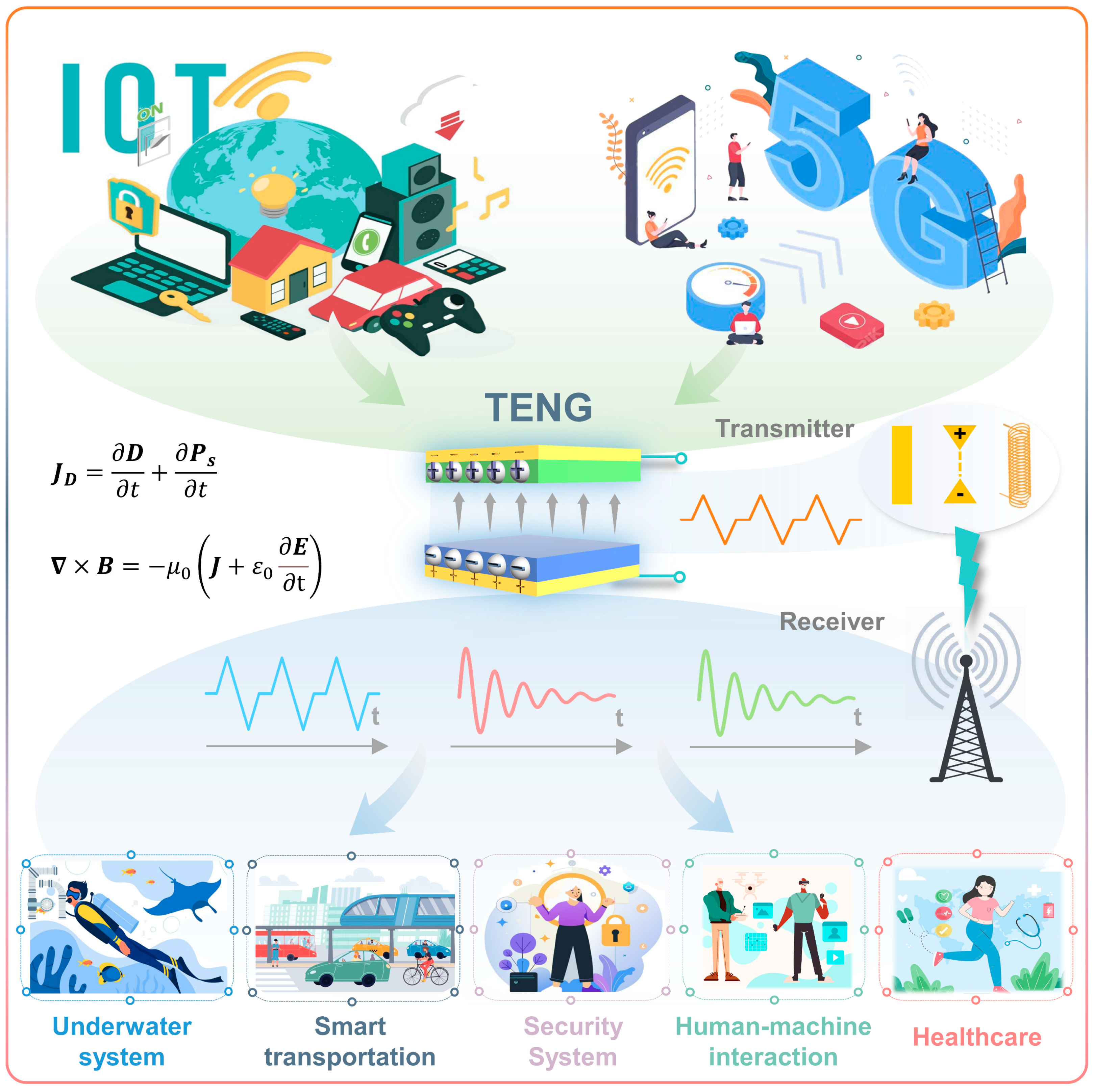
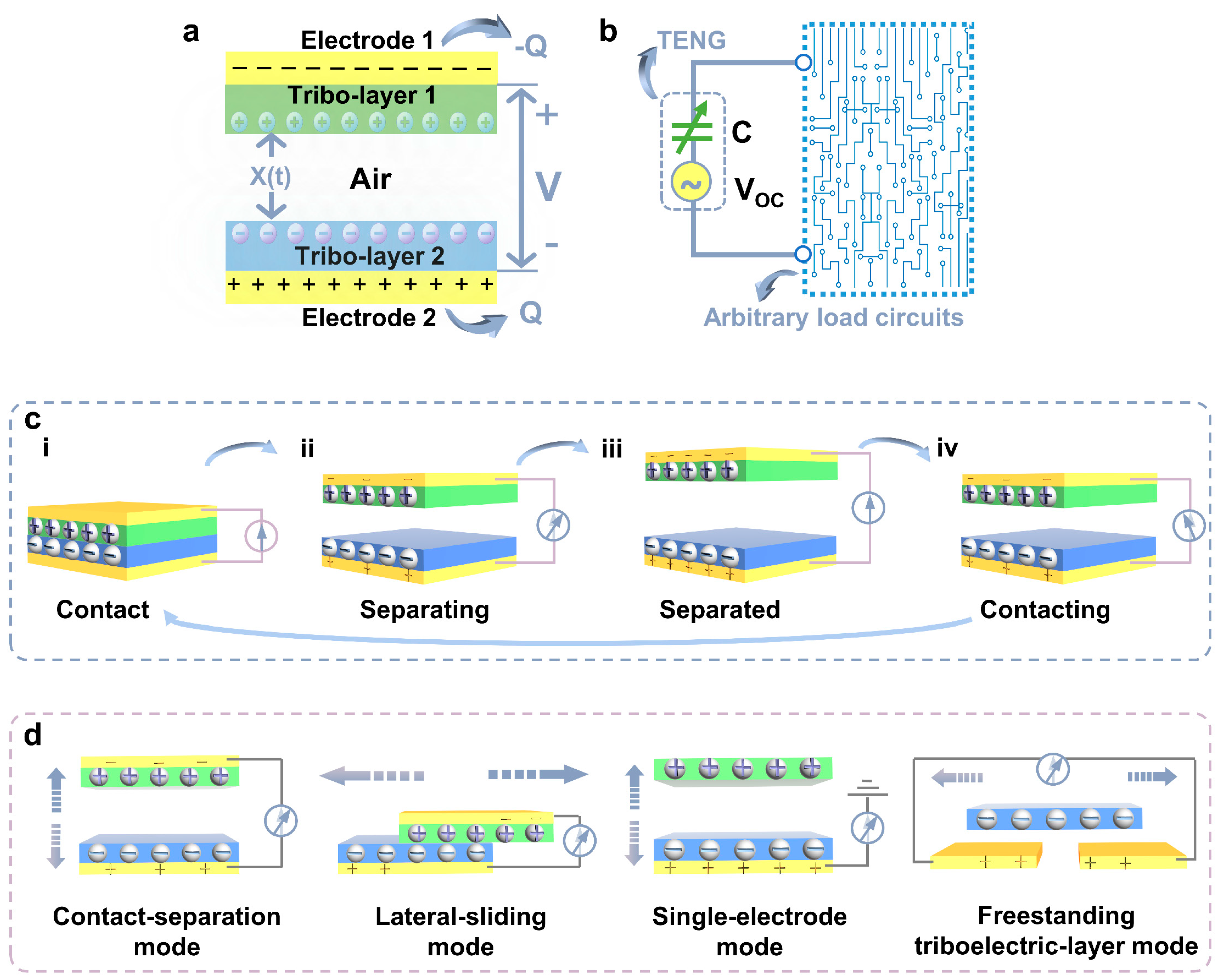

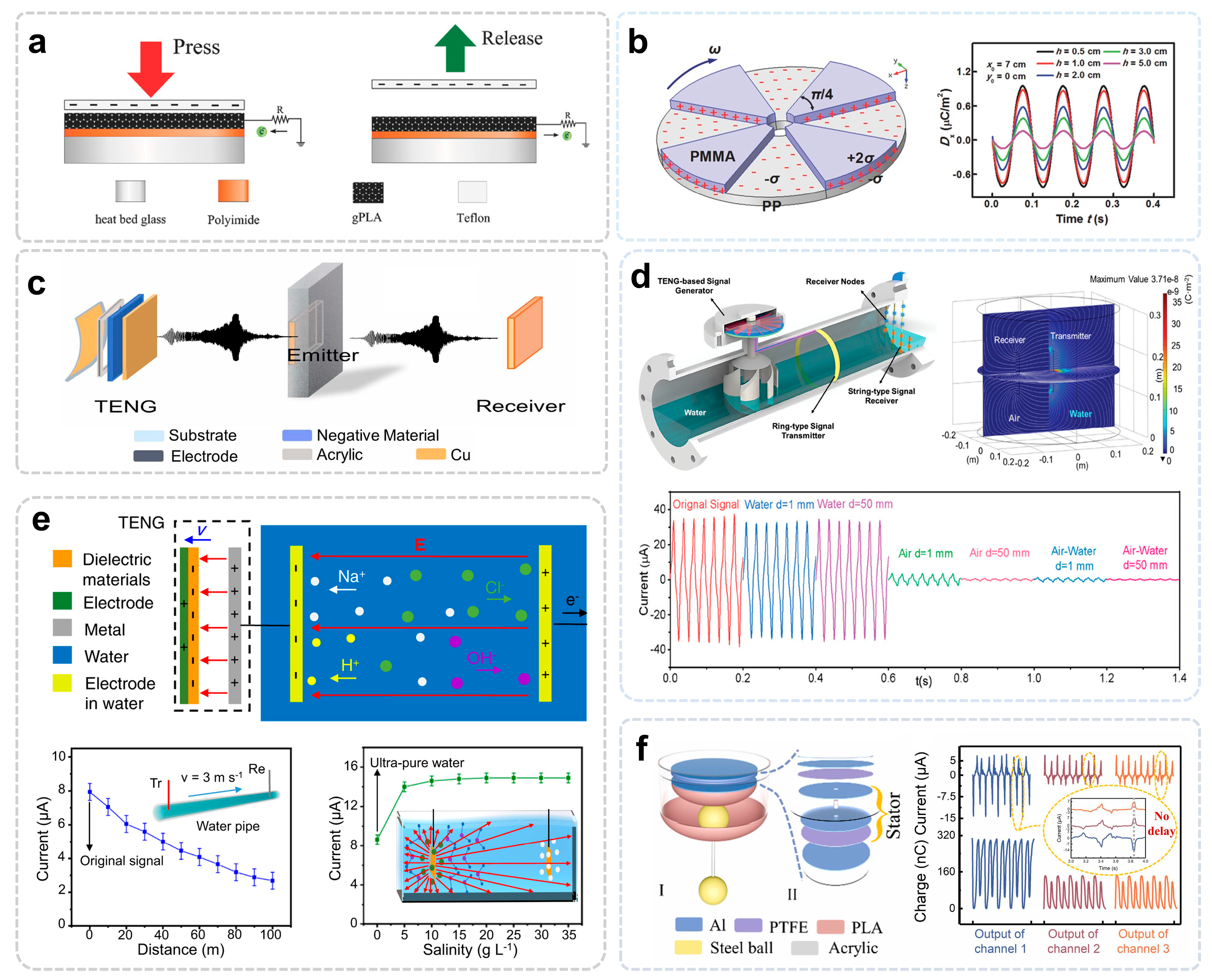
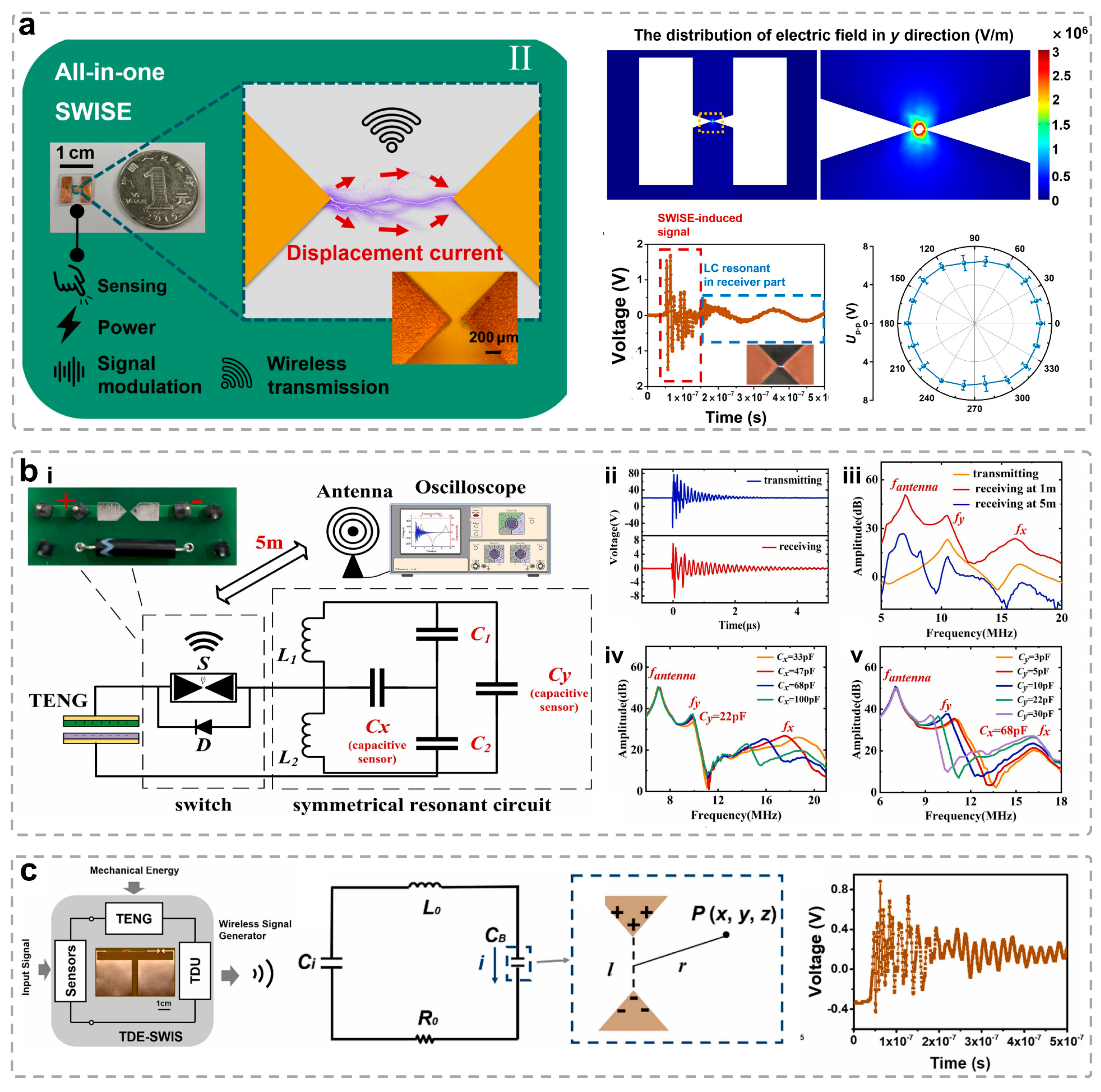

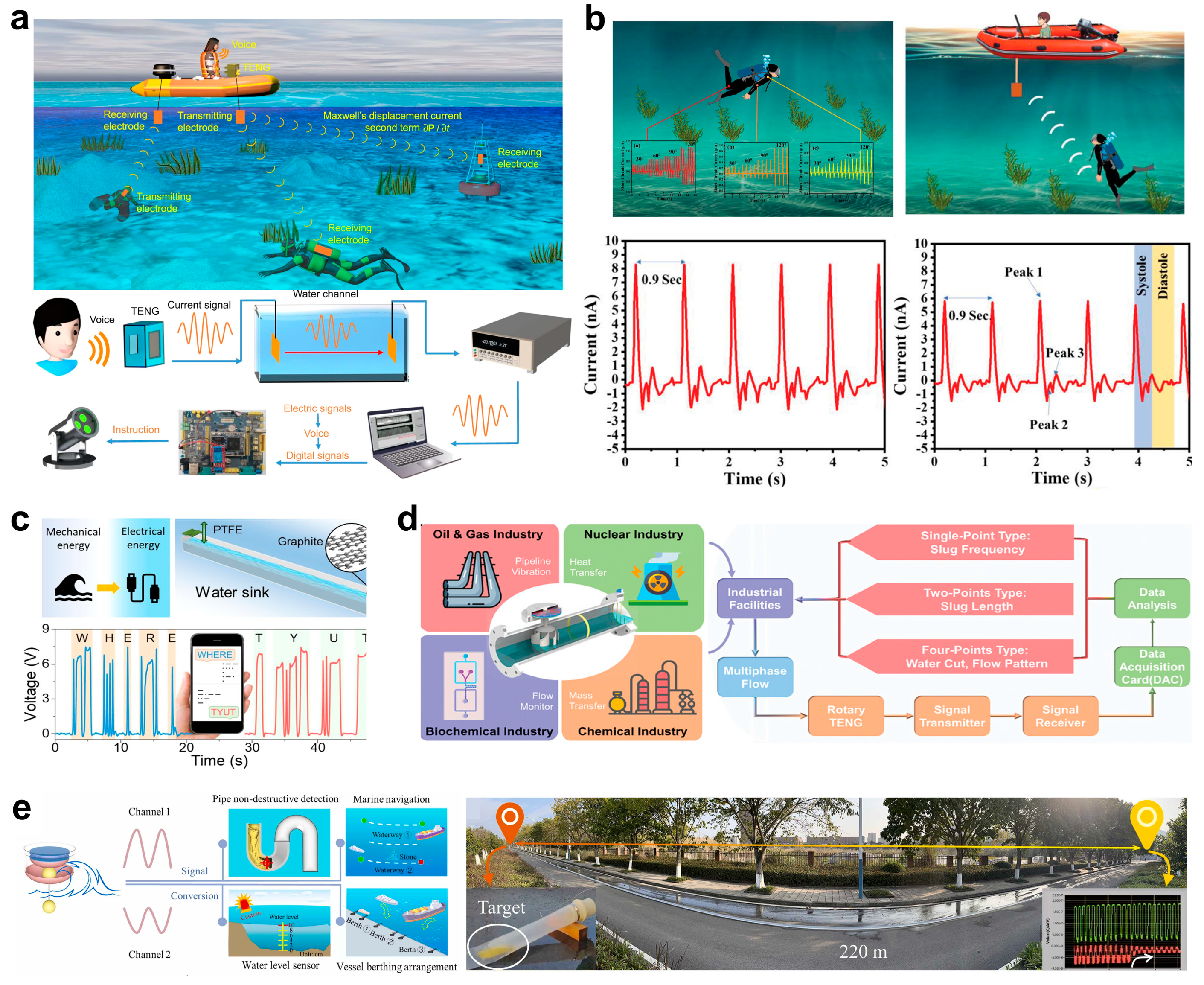
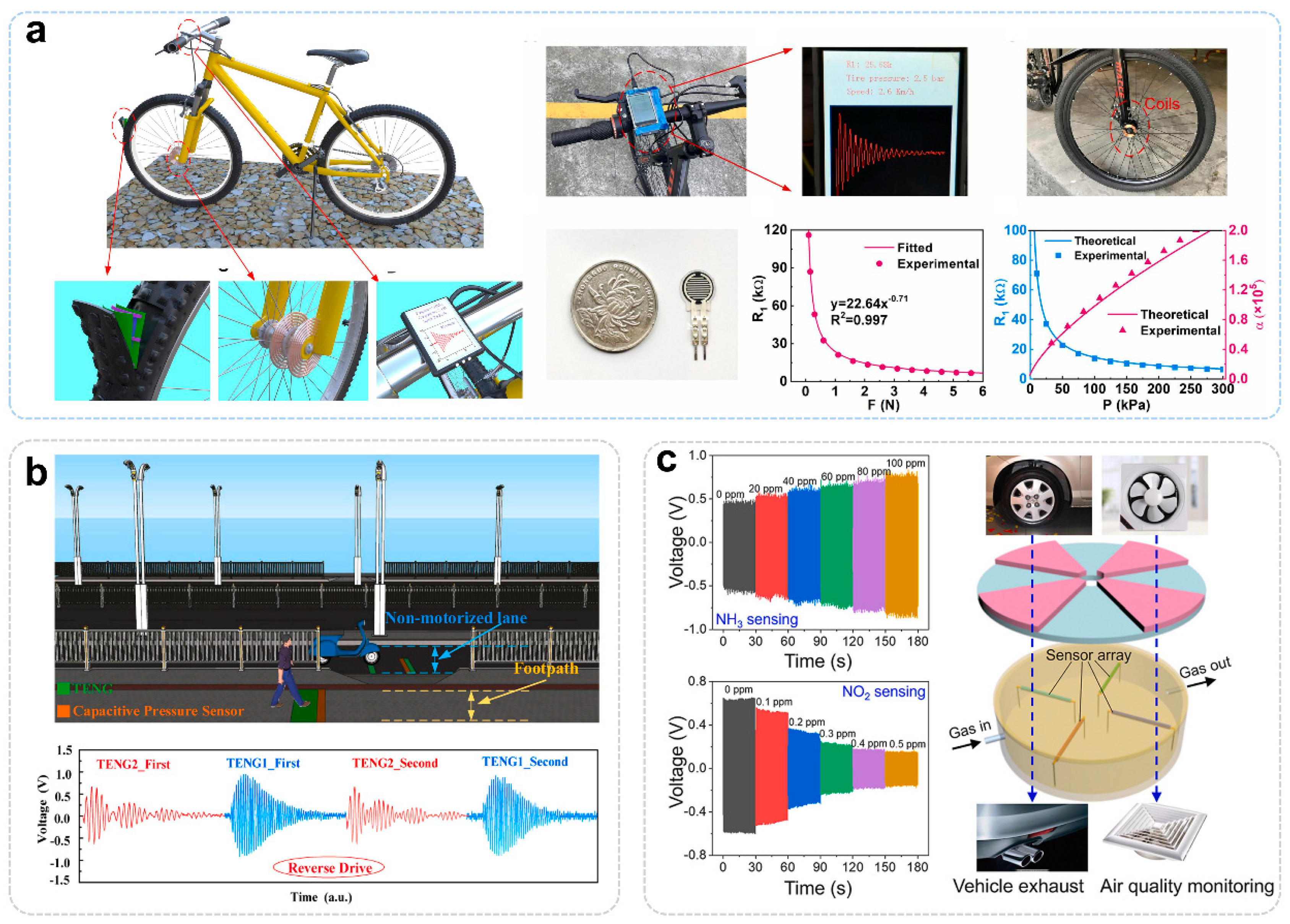
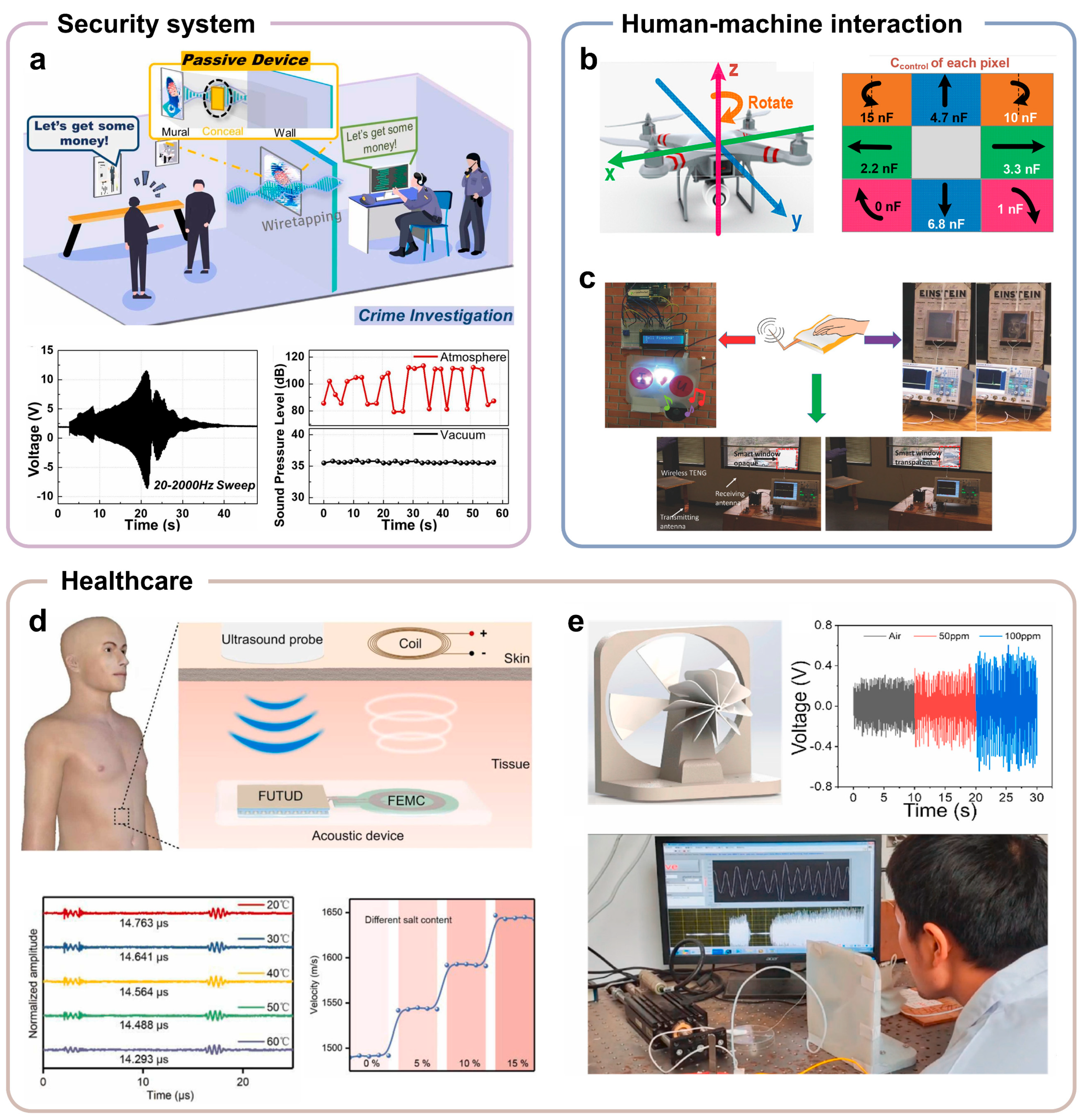
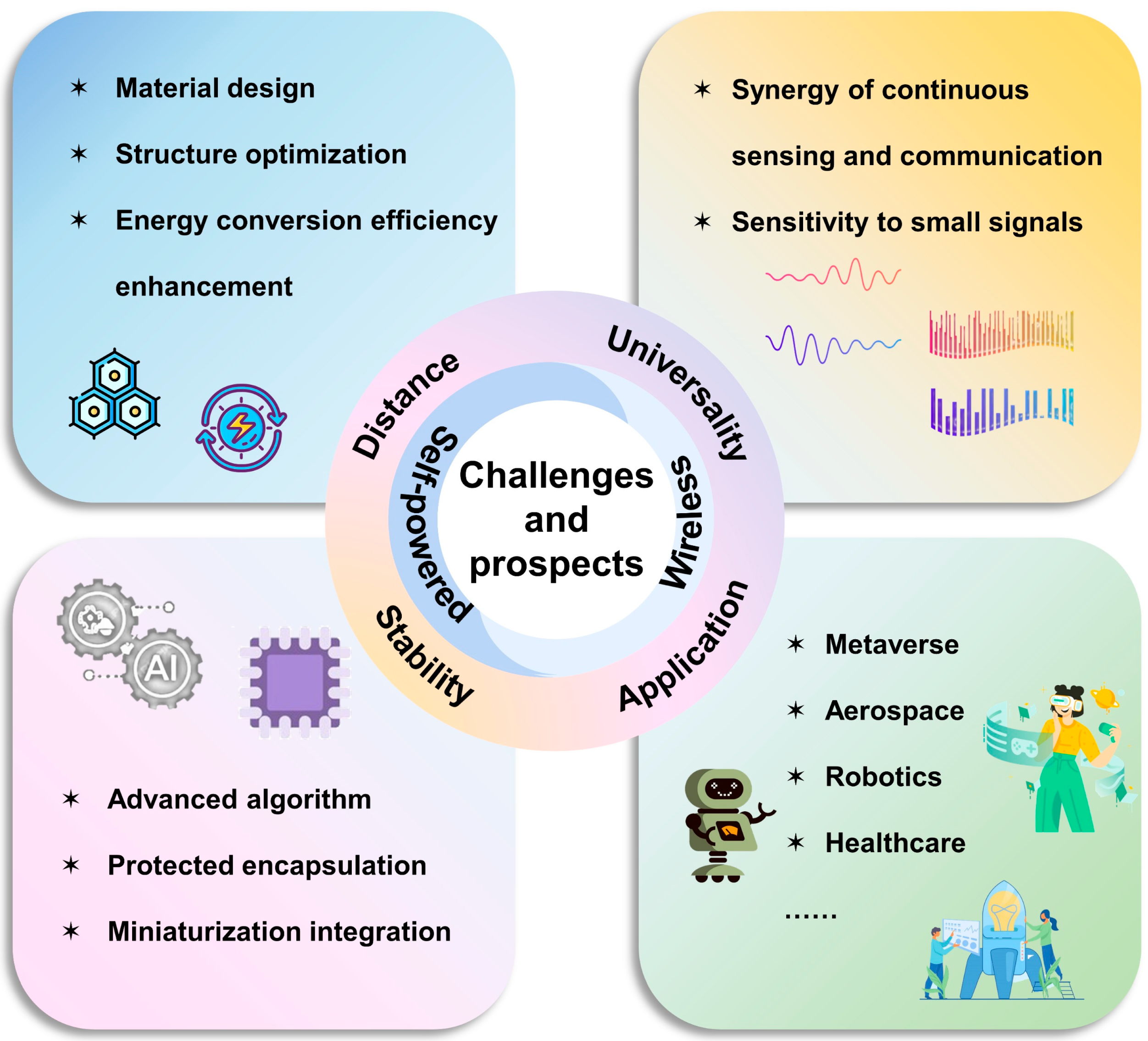
| Communication Model | Signal Characteristics | Triboelectric Materials | Sizes | Operating Mode | Transmitted Signal Amplitude | Receiving Signal Amplitude | Communication Distance (Medium) | Ref. |
|---|---|---|---|---|---|---|---|---|
| Electric displacement field (via plane electrode or tribo-charged surface) | Typical pulse waveform/resonant waveform | gPLA/Teflon | 16 × 18 cm2 | SE | ~1500 V | \ | 3 m (in air) | [76] |
| PA6/PTFE | 5 × 5 cm2 | CS | 1950 V | 710 mV | 2.3 m (in air) | [99] | ||
| Al/FEP | 4.5 × 4.5 cm2 | SE | 13 V/14.5 μA | ~2 μA | ~100 m (in water) | [96] | ||
| Nylon 66/Ni-MOF/PVDF CNF | 3 × 3 cm2 | SE | 45 V/0.77 μA | ~3 nA | 5 m (in water) | [81] | ||
| Al/PTFE | 153.86 mm2 | CS | 345.2 V/29.2 μA | \ | 220 m (in water) | [100] | ||
| Modulated electromagnetic wave (via breakdown discharger) | Resonant waveform | Skin/FEP | 9 × 9 mm2 | \ | \ | \ | 30 m (in air) | [98] |
| PA66/FEP | 5 × 5 cm2 | CS | 600 V | ~0.2 V | 5 m (in air) | [82] | ||
| Modulated electromagnetic wave (via coupling inductor coil) | Resonant waveform | PA6/PDMS | 4 × 5 cm2 | CS | ~1000 V | \ | ~45 cm (in air) | [101] |
| PA66/FEP | 5 × 5 cm2 | CS | 1700 V | ~500 mV | 90 cm (in air) | [102] | ||
| PA66/FEP | \ | CS | 590 V | ~500 mV | 1 m (in air) | [103] | ||
| Rabbit fur/PTFE | 530 mm2 | FS | ~1000 V | 3 V | 40 m (in air) | [104] | ||
| PA6/PDMS | 4 × 4 cm2 | CS | ~50 V | 25 mV | ~12 cm (in air) | [105] | ||
| Nitrile/Ecoflex | 8 × 8 cm2 | CS | ~100 V | \ | 1 m (in air) | [106] |
Disclaimer/Publisher’s Note: The statements, opinions and data contained in all publications are solely those of the individual author(s) and contributor(s) and not of MDPI and/or the editor(s). MDPI and/or the editor(s) disclaim responsibility for any injury to people or property resulting from any ideas, methods, instructions or products referred to in the content. |
© 2024 by the authors. Licensee MDPI, Basel, Switzerland. This article is an open access article distributed under the terms and conditions of the Creative Commons Attribution (CC BY) license (https://creativecommons.org/licenses/by/4.0/).
Share and Cite
Zhang, H.; Liu, Z.; Xie, X.; Wu, J.; Shi, Q. Self-Powered Sensing and Wireless Communication Synergic Systems Enabled by Triboelectric Nanogenerators. Nanoenergy Adv. 2024, 4, 367-398. https://doi.org/10.3390/nanoenergyadv4040023
Zhang H, Liu Z, Xie X, Wu J, Shi Q. Self-Powered Sensing and Wireless Communication Synergic Systems Enabled by Triboelectric Nanogenerators. Nanoenergy Advances. 2024; 4(4):367-398. https://doi.org/10.3390/nanoenergyadv4040023
Chicago/Turabian StyleZhang, Huiyun, Zhengfeng Liu, Xinkai Xie, Jun Wu, and Qiongfeng Shi. 2024. "Self-Powered Sensing and Wireless Communication Synergic Systems Enabled by Triboelectric Nanogenerators" Nanoenergy Advances 4, no. 4: 367-398. https://doi.org/10.3390/nanoenergyadv4040023
APA StyleZhang, H., Liu, Z., Xie, X., Wu, J., & Shi, Q. (2024). Self-Powered Sensing and Wireless Communication Synergic Systems Enabled by Triboelectric Nanogenerators. Nanoenergy Advances, 4(4), 367-398. https://doi.org/10.3390/nanoenergyadv4040023










